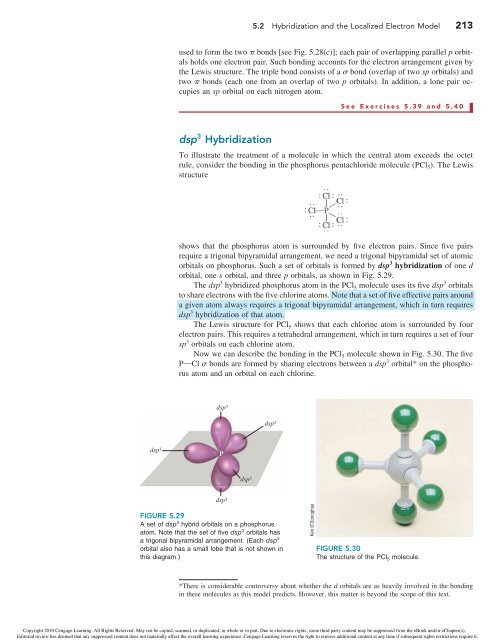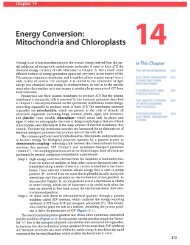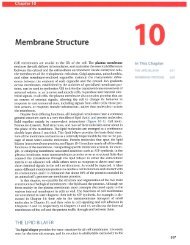Ch05 Molecular Structure and Orbitals.pdf - finedrafts
Ch05 Molecular Structure and Orbitals.pdf - finedrafts
Ch05 Molecular Structure and Orbitals.pdf - finedrafts
You also want an ePaper? Increase the reach of your titles
YUMPU automatically turns print PDFs into web optimized ePapers that Google loves.
dsp 3<br />
5.2 Hybridization <strong>and</strong> the Localized Electron Model 213<br />
used to form the two bonds [see Fig. 5.28(c)]; each pair of overlapping parallel p orbitals<br />
holds one electron pair. Such bonding accounts for the electron arrangement given by<br />
the Lewis structure. The triple bond consists of a bond (overlap of two sp orbitals) <strong>and</strong><br />
two bonds (each one from an overlap of two p orbitals). In addition, a lone pair occupies<br />
an sp orbital on each nitrogen atom.<br />
dsp 3 Hybridization<br />
See Exercises 5.39 <strong>and</strong> 5.40<br />
To illustrate the treatment of a molecule in which the central atom exceeds the octet<br />
rule, consider the bonding in the phosphorus pentachloride molecule (PCl 5). The Lewis<br />
structure<br />
shows that the phosphorus atom is surrounded by ve electron pairs. Since ve pairs<br />
require a trigonal bipyramidal arrangement, we need a trigonal bipyramidal set of atomic<br />
orbitals on phosphorus. Such a set of orbitals is formed by dsp 3 hybridization of one d<br />
orbital, one s orbital, <strong>and</strong> three p orbitals, as shown in Fig. 5.29.<br />
The dsp 3 hybridized phosphorus atom in the PCl 5 molecule uses its ve dsp 3 orbitals<br />
to share electrons with the ve chlorine atoms. Note that a set of ve effective pairs around<br />
a given atom always requires a trigonal bipyramidal arrangement, which in turn requires<br />
dsp 3 hybridization of that atom.<br />
The Lewis structure for PCl 5 shows that each chlorine atom is surrounded by four<br />
electron pairs. This requires a tetrahedral arrangement, which in turn requires a set of four<br />
sp 3 orbitals on each chlorine atom.<br />
Now we can describe the bonding in the PCl 5 molecule shown in Fig. 5.30. The ve<br />
POCl bonds are formed by sharing electrons between a dsp 3 orbital* on the phosphorus<br />
atom <strong>and</strong> an orbital on each chlorine.<br />
dsp 3<br />
P<br />
dsp 3<br />
dsp 3<br />
dsp 3<br />
FIGURE 5.29<br />
A set of dsp 3 hybrid orbitals on a phosphorus<br />
atom. Note that the set of five dsp 3 orbitals has<br />
a trigonal bipyramidal arrangement. (Each dsp 3<br />
orbital also has a small lobe that is not shown in<br />
this diagram.)<br />
Ken O’Donoghue<br />
FIGURE 5.30<br />
The structure of the PCI 5 molecule.<br />
*There is considerable controversy about whether the d orbitals are as heavily involved in the bonding<br />
in these molecules as this model predicts. However, this matter is beyond the scope of this text.<br />
Copyright 2010 Cengage Learning. All Rights Reserved. May not be copied, scanned, or duplicated, in whole or in part. Due to electronic rights, some third party content may be suppressed from the eBook <strong>and</strong>/or eChapter(s).<br />
Editorial review has deemed that any suppressed content does not materially affect the overall learning experience. Cengage Learning reserves the right to remove additional content at any time if subsequent rights restrictions require it.






